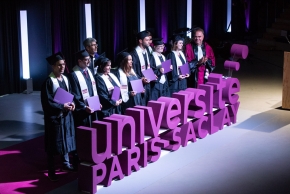Roland AKIKI
Titre
Géométrie et Précision dans le Traitement de Sentinel-1 pour des Applications Interférométriques
Résumé
Cette thèse explore les techniques avancées de traitement des données du radar à synthèse d'ouverture (RSO, ou SAR en anglais) du satellite Sentinel-1 et se concentre sur les questions liées à la précision, à la géométrie et à l'efficacité avec des applications à l'interférométrie (InSAR). La première partie de la thèse étudie le recalage et la modélisation géométrique de Sentinel-1. Tout d'abord, nous comparons différentes approches de deramping pour Sentinel-1 et mettons en évidence les compromis entre efficacité et précision. Ensuite, nous appliquons avec succès un algorithme pour estimer les modèles de caméra RPC à partir de correspondances de points 3D-2D sur les images Sentinel-1 et Wordlview-3. Le dernier chapitre de la première partie propose une méthode pour améliorer la précision de l'assemblage des bursts de Sentinel-1 et du recalage géométrique en tenant compte des corrections fines du modèle de géolocalisation. Il en résulte une série temporelle de mosaïques Sentinel-1 bien alignées et géométriquement cohérentes. La deuxième partie de la thèse évalue la performance des méthodes d'apprentissage profond existantes pour les tâches InSAR telles que le débruitage de phase, l'estimation de la cohérence et le déroulement de phase. La dernière partie présente une application InSAR sur les cuves de stockage de pétrole brut. Nous montrons la corrélation entre la double différence de la phase InSAR sur les réflecteurs fixes voisins des cuves et la double différence du taux de remplissage des cuves. Nos résultats indiquent que les réflecteurs sur le toit d'une cuve s'éloignent du satellite d'environ 1 cm lorsqu'elle se remplit. Notre étude souligne la nécessité d'exigences strictes en matière de précision et de traitement de certaines applications InSAR localisées. En conclusion, ce travail met en évidence les aspects liés à la géométrie et à la précision du traitement de Sentinel-1, qui pourraient bénéficier à la fois aux applications SAR et InSAR à grande échelle et localisées.
Mots clés
Interférométrie,Géométrie,Précision,Sentinel-1,Double différence de phase,Déformation
Title
Geometry and Precision in Sentinel-1 Processing for Interferometric Applications
Abstract
This thesis explores advanced techniques for processing Sentinel-1 Synthetic Aperture Radar (SAR) data and focuses on questions related to precision, geometry, and efficiency with applications to interferometry (InSAR). The first part of the thesis studies the coregistration and geometric modeling of Sentinel-1. First, we compare different deramping approaches for Sentinel-1 and highlight the tradeoffs between efficiency and precision. Then, we successfully apply an algorithm to fit RPC camera models from 3D-2D point correspondences on Sentinel-1 and Wordlview-3 images. The last chapter in the first part proposes a method to improve the precision of Sentinel-1 burst stitching and geometric coregistration by accounting for fine corrections of the geolocation model. This results in a time series of well-aligned, geometrically consistent Sentinel-1 mosaics. The second part of the thesis evaluates the performance of existing deep learning methods for InSAR tasks such as phase denoising, coherence estimation, and phase unwrapping. The last part presents an InSAR application on crude oil storage tanks. We show the correlation between the double difference of the InSAR phase on neighboring fixed reflectors on the tanks and the double difference of the tanks' fill ratio. Our results indicate that the reflectors on the roof of a tank move away from the satellite by around 1 cm when it fills up. Our study underlines the need for stringent requirements on the precision and processing of some localized InSAR applications. In conclusion, in this work, we highlight aspects related to the geometry and the precision of Sentinel-1 processing, which could benefit both wide-area and localized SAR and InSAR applications.
Keywords
Interferometry, Geometry, Precision, Sentinel-1, Double phase difference, Deformation
Direction de thèse
Jean-michel MOREL, Gabriele FACCIOLO, Raphaël GRANDIN
